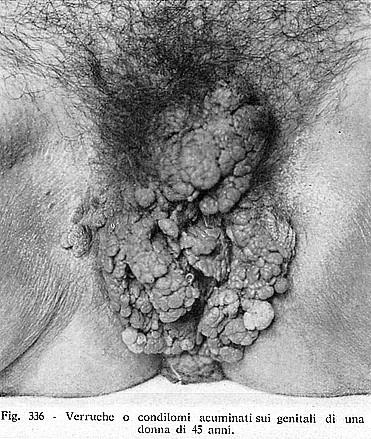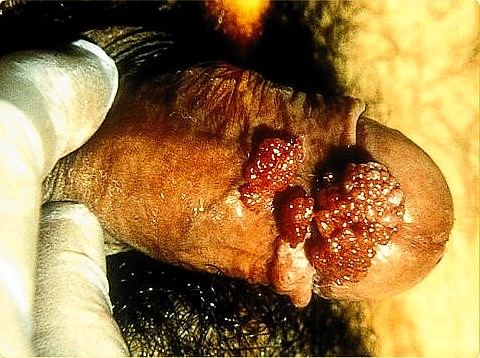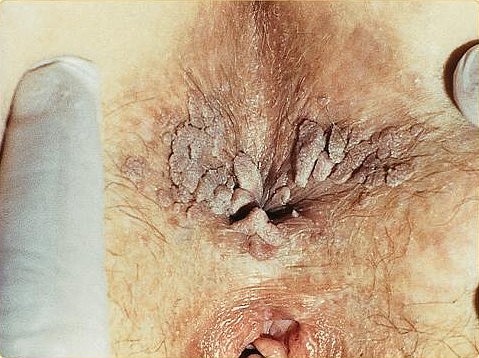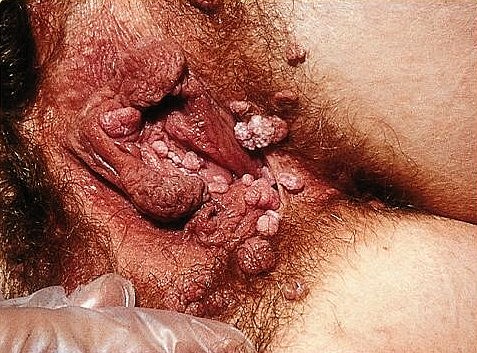Lessico
Condilomi acuminati
Creste di gallo

Malattie
della pelle
di George Clinton Andrews & Gilberto Manganotti
Edizioni Minerva Medica – Torino - 1964
Il termine condiloma deriva dal greco kondýløma che significa ingrossamento, nodo, callosità. Si tratta di un'escrescenza di tipo verrucoso che sorge, in genere, sulla cute o sulla mucosa genitale o nella zona perianale. I condilomi, all'origine, hanno l'aspetto di piccoli bottoncini carnosi o di rilievi filiformi, ma in seguito possono assumere forme varie. Sono anche detti creste di gallo o condilomi. acuminati. Se non sopravvengono complicazioni, le manifestazioni sono indolenti, il decorso è lento e la durata indefinita.
La formazione dei condilomi è il risultato di un'infezione da parte di alcuni virus (Papillomavirus) che si trasmette durante i rapporti sessuali e ha un periodo d'incubazione da 1 a 6 mesi. Nell'uomo sono presenti nel meato uretrale e lungo il frenulo e il solco balanoprepuziale, oppure intorno all'ano. Nella donna interessano la vulva, la vagina e il collo dell'utero.
I condilomi richiedono una terapia che può essere sia farmacologica a base di applicazioni locali di una soluzione alcolica di podofillotossina (contenuta nella resina di alcune specie di piante del genere Podophyllum in grado di impedire la mitosi cellulare che nelle cellule infettate dal virus è accelerata) o di farmaci antivirali per via generale (interferone, gruppo di proteine prodotte da cellule animali capaci di prevenire e di bloccare la riproduzione intracellulare dei virus), sia di rimozione con elettrocauterio o con un vero e proprio intervento chirurgico. Le ricadute sono comunque frequenti. Oggi la fotocoagulazione laser sta ottenendo un numero elevato di guarigioni.

Genital warts (or Condyloma, Condylomata acuminata, or venereal warts) is a highly contagious sexually transmitted infection caused by some sub-types of human papillomavirus (HPV). It is spread through direct skin-to-skin contact during oral, genital, or anal sex with an infected partner. Genital warts are the most easily recognized sign of genital HPV infection. They can be caused by strains 6, 11, 30, 42, 43, 44, 45, 51, 52 and 54 of genital HPV; types 6 and 11 are responsible for 90% of genital warts cases. Most people who acquire those strains never develop warts or any other symptoms.
HPV also causes many cases of cervical cancer; types 16 and 18 account for 70% of cases; however, the strains of HPV that cause genital warts are not linked to the strains that cause cancer.

Genital warts often occur in clusters and can be very tiny or can spread into large masses in the genital or penis area. In women they occur on the outside and inside of the vagina, on the opening (cervix) to the womb (uterus), or around the anus.
They are approximately as prevalent in men, but the symptoms may be less obvious. When present, they usually are seen on the tip of the penis. They also may be found on the shaft of the penis, on the scrotum, or around the anus. Rarely, genital warts also can develop in the mouth or throat of a person who has had oral sex with an infected person.
The viral particles are able to penetrate the skin and mucosal surfaces through microscopic abrasions in the genital area, which occur during sexual activity. Once cells are invaded by HPV, a latency (quiet) period of months to years may occur. The latency period just means the HPV virus is in an incubation period. Having sex with a partner whose HPV infection is in the incubation period still leaves you vulnerable to becoming infected yourself. In other words, just because one can't see the genital warts, doesn't mean they are not there. HPV virus can last from 3 months to 2 years without a symptom. That causes the increase of HPV infectors and sometimes you cannot track down who was the source of the infection.

Genital warts may disappear without treatment, but sometimes eventually develop a fleshy, small raised growth. There is no way to predict whether they will grow or disappear.
Depending on the size and location of the wart, and other factors, a doctor will offer one of several ways to treat them.
Imiquimod
(Aldara®) a topical immune response cream, applied to the affected area
A 20% podophyllin anti-mitotic solution, applied to the affected area and
later washed off
A 0.5% podofilox solution, applied to the affected area but not to be washed
off
A 5% 5-fluorouracil (5-FU) cream
Trichloroacetic acid (TCA)
Pulsed dye laser
Liquid nitrogen cryosurgery
Electric or laser cauterization
Podophyllin and podofilox should not be used during pregnancy, as they are absorbed by the skin and may cause birth defects in the fetus. 5-fluorouracil cream should not be used while trying to become pregnant or if there is a possibility of pregnancy.
Small warts can be removed by freezing (cryosurgery), burning (electrocautery), or laser treatment. Surgery is occasionally used to remove large warts that have not responded to other treatment.
Some doctors inject the antiviral drug interferon-alpha directly into the warts, to treat warts that have returned after removal by traditional means. The drug is expensive, and does not reduce the rate that the warts return.
Although treatments can remove the warts, they do not remove the HPV virus, so warts can recur after treatment. Traditional theories postulated that the virus remained in the body for a lifetime. However, new studies using sensitive DNA techniques have shown that through immunological response the virus can either be cleared or suppressed to levels below what PCR tests can measure.
According to the Center for Disease Control's report on HPV to Congress in 2004, studies have shown that 70% of new HPV infections clear within one year, and as many as 91% clear within two years. The median duration of new infections is typically eight months. The gradual development of an effective immune response is thought to be the likely mechanism for HPV DNA clearance. The state of the immune system determines the chances of removing the virus entirely and can be affected by factors such as HIV infection, certain medications, stress, or illness. There is even some suggestion that effective treatment of the wart may aid the body's immune response.
It is a common misconception among men that hirsuties papillaris genitalis are genital warts. Hirsuties papillaris genitalis is not contagious and no treatment for it is necessary. Some may deem it unsightly and there are various methods of ridding the penis of the condition such as carbon dioxide laser treatment.
Genital warts (condylomata) should not be confused with Molluscum contagiosum (MC), which is often transmitted sexually, but does not occur internally as do condylomata. MC looks like small warts, which are much smaller than condylomata genital warts. It does not increase the risk of cervical cancer for women. Genital warts should not be confused with Fordyce's spots, which are considered benign.